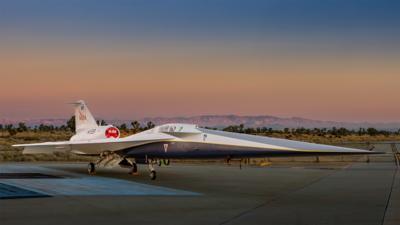Mon, Jan 15, 2024
New Supersonic Prototype Aims to Soften the Blow When Going Beyond Mach 1
No more CGI for the next-gen x-plane from NASA and Lockheed Martin now that the duo has finally debuted the quiet supersonic aircraft live in the metal.

The X-59 Quesst aircraft is a demonstrator to bear out the possibility of supersonic flight without the sonic booms. If successful, the concept will revolutionize public air travel with a whole new niche of high-flying, fast-moving, supersonic aircraft. The Concorde took a swing at the supersonic passenger craft idea, but it ultimately died a slow, expensive market death as its destinations limited its performance to reduce noise on the ground. That apparently ended supersonic pax carriage for good, but new money, new ideas, and fresh materials lie ready and waiting to take another crack at the market.
“This is a major accomplishment made possible only through the hard work and ingenuity from NASA and the entire X-59 team,” said NASA Deputy Administrator Pam Melroy. “In just a few short years we’ve gone from an ambitious concept to reality. NASA’s X-59 will help change the way we travel, bringing us closer together in much less time.”
Melroy was joined by brass from Lockheed and NASA at a ceremony revealing the Quesst demonstrator at the former's Skunk Works facility in Palmdale, California. The aircraft, if successful, won't necessarily be completely free of sonic booms, however. NASA wants to reduce the effect of the supersonic crack with sculpting, shaping, and materials placement that will slough off and delay the transition to supersonic along the body of the aircraft. If successful, the Quesst demonstrator will hit its supersonic cruise of 925 mph or 1.4 mach with a quiet "thump" instead of a loud "boom".
“It’s thrilling to consider the level of ambition behind Quesst and its potential benefits,” said Bob Pearce, associate administrator for aeronautics research at NASA Headquarters in Washington. “NASA will share the data and technology we generate from this one-of-a-kind mission with regulators and with industry. By demonstrating the possibility of quiet commercial supersonic travel over land, we seek to open new commercial markets for U.S. companies and benefit travelers around the world.”
More News
After Draining Both Wing Fuel Tanks, A Significant Amount Of Water Was Observed In The Right Wing Fuel Tank Analysis: The pilot, who was also the owner of the experimental amateur->[...]
“Airbus apologises for any challenges and delays caused to passengers and airlines by this event. The Company thanks its customers, the authorities, its employees and all rel>[...]
High Speed Taxiway A long radius taxiway designed and provided with lighting or marking to define the path of aircraft, traveling at high speed (up to 60 knots), from the runway ce>[...]
Aero Linx: Taylorcraft Foundation, Inc. The Taylorcraft Foundation is exclusively organized for charitable, educational & scientific activities and will preserve the history an>[...]
Also: USAF Reaper Accident, Baikonur Damage, Horizon eVTOL IFR/FIKI, New Glenn Update Honda has outlined its clearest timeline yet for its entry into the world of electric vertical>[...]
 NTSB Final Report: Patriot Aircraft LLC CX1900A
NTSB Final Report: Patriot Aircraft LLC CX1900A Aero-News: Quote of the Day (12.06.25)
Aero-News: Quote of the Day (12.06.25) ANN's Daily Aero-Term (12.06.25): High Speed Taxiway
ANN's Daily Aero-Term (12.06.25): High Speed Taxiway ANN's Daily Aero-Linx (12.06.25)
ANN's Daily Aero-Linx (12.06.25) Airborne-NextGen 12.02.25: Honda eVTOL, Arctus High-Alt UAS, Samson Patent
Airborne-NextGen 12.02.25: Honda eVTOL, Arctus High-Alt UAS, Samson Patent



